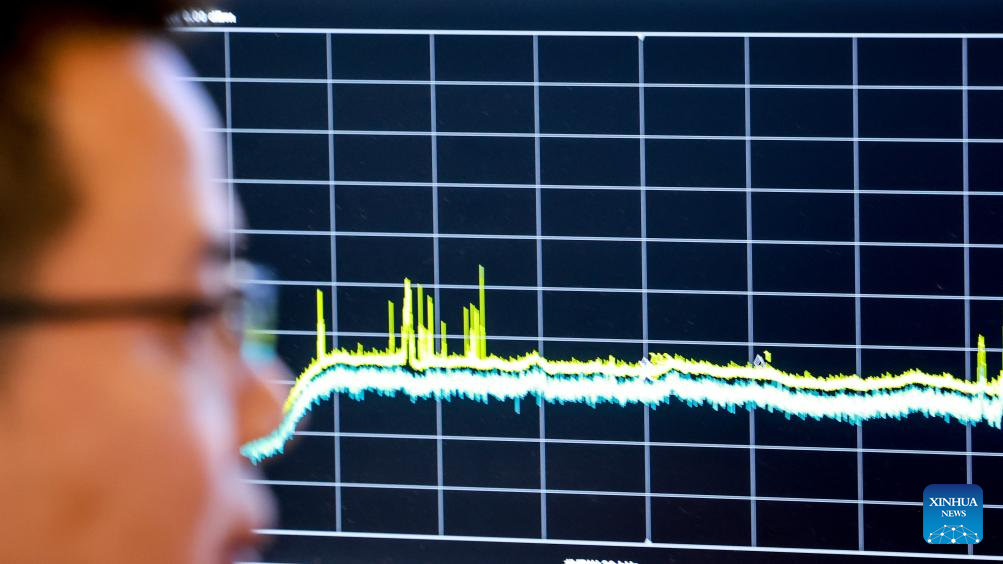China's gigantic telescope deciphers relativistic jets of black hole

This aerial panoramic photo taken on July 26, 2023 shows China's Five-hundred-meter Aperture Spherical Radio Telescope (FAST) in southwest China's Guizhou Province. An international research team led by Chinese astronomers revealed the complex dynamic features of relativistic jets of a black hole, according to a study published in the journal Nature. (Xinhua/Ou Dongqu)
BEIJING, July 27 (Xinhua) -- An international research team led by Chinese astronomers revealed the complex dynamic features of relativistic jets of a black hole, according to a study published in the journal Nature.
Powerful relativistic jets are one of the features of accreting black holes, and GRS 1915+105 is a well-known fast-spinning black-hole X-ray binary with a relativistic jet, termed a "microquasar," as indicated by its superluminal motion of radio emission, according to the study.
It has exhibited persistent X-ray activity over the last 30 years, with quasiperiodic oscillations in the X-ray band.
From 2020 to 2022, researchers from the Department of Astronomy of Wuhan University, the National Astronomical Observatories of the Chinese Academy of Sciences, and other institutions employed China's Five-hundred-meter Aperture Spherical Radio Telescope (FAST), the world's largest single-dish radio telescope, to observe the radio continuous spectrum light change and polarization of GRS 1915+105.
With FAST's high sampling and sensitivity, the research team detected two instances of transient periodic oscillation of about 0.2 seconds in January 2021 and June 2022, respectively.
The transient periodic oscillations remain unstable and unable to be detected most of the time. It is therefore named quasiperiodic oscillations.
This is the first time that sub-second low-frequency radio quasiperiodic oscillations in a microquasar have been observed in the world, which also directly links the phenomenon with relativistic jets.
It is of great scientific significance to reveal the origin and dynamic process of relativistic radio jets of super-dense celestial bodies and will open up a new avenue for radio observation and theoretical research of black holes.

This aerial panoramic photo taken on July 26, 2023 shows China's Five-hundred-meter Aperture Spherical Radio Telescope (FAST) in southwest China's Guizhou Province. An international research team led by Chinese astronomers revealed the complex dynamic features of relativistic jets of a black hole, according to a study published in the journal Nature. (Xinhua/Ou Dongqu)

This aerial panoramic photo taken on July 26, 2023 shows China's Five-hundred-meter Aperture Spherical Radio Telescope (FAST) in southwest China's Guizhou Province. An international research team led by Chinese astronomers revealed the complex dynamic features of relativistic jets of a black hole, according to a study published in the journal Nature. (Xinhua/Ou Dongqu)

This aerial panoramic photo taken on July 26, 2023 shows China's Five-hundred-meter Aperture Spherical Radio Telescope (FAST) in southwest China's Guizhou Province. An international research team led by Chinese astronomers revealed the complex dynamic features of relativistic jets of a black hole, according to a study published in the journal Nature. (Xinhua/Ou Dongqu)

This aerial panoramic photo taken on July 26, 2023 shows China's Five-hundred-meter Aperture Spherical Radio Telescope (FAST) in southwest China's Guizhou Province. An international research team led by Chinese astronomers revealed the complex dynamic features of relativistic jets of a black hole, according to a study published in the journal Nature. (Xinhua/Ou Dongqu)

This aerial panoramic photo taken on July 26, 2023 shows China's Five-hundred-meter Aperture Spherical Radio Telescope (FAST) in southwest China's Guizhou Province. An international research team led by Chinese astronomers revealed the complex dynamic features of relativistic jets of a black hole, according to a study published in the journal Nature. (Xinhua/Ou Dongqu)

This aerial panoramic photo taken on July 26, 2023 shows China's Five-hundred-meter Aperture Spherical Radio Telescope (FAST) in southwest China's Guizhou Province. An international research team led by Chinese astronomers revealed the complex dynamic features of relativistic jets of a black hole, according to a study published in the journal Nature. (Xinhua/Ou Dongqu)

This aerial panoramic photo taken on July 26, 2023 shows China's Five-hundred-meter Aperture Spherical Radio Telescope (FAST) in southwest China's Guizhou Province. An international research team led by Chinese astronomers revealed the complex dynamic features of relativistic jets of a black hole, according to a study published in the journal Nature. (Xinhua/Ou Dongqu)

A staff member works at the control room of China's Five-hundred-meter Aperture Spherical Radio Telescope (FAST) in Pingtang County, southwest China's Guizhou Province, July 25, 2023. An international research team led by Chinese astronomers revealed the complex dynamic features of relativistic jets of a black hole, according to a study published in the journal Nature. (Xinhua/Ou Dongqu)

This photo taken on July 26, 2023 shows the feed cabin of China's Five-hundred-meter Aperture Spherical Radio Telescope (FAST) under maintenance in southwest China's Guizhou Province. An international research team led by Chinese astronomers revealed the complex dynamic features of relativistic jets of a black hole, according to a study published in the journal Nature. (Xinhua/Ou Dongqu)

This aerial panoramic photo taken on July 26, 2023 shows China's Five-hundred-meter Aperture Spherical Radio Telescope (FAST) in southwest China's Guizhou Province. An international research team led by Chinese astronomers revealed the complex dynamic features of relativistic jets of a black hole, according to a study published in the journal Nature.
(Xinhua/Ou Dongqu)

This aerial panoramic photo taken on July 26, 2023 shows China's Five-hundred-meter Aperture Spherical Radio Telescope (FAST) in southwest China's Guizhou Province. An international research team led by Chinese astronomers revealed the complex dynamic features of relativistic jets of a black hole, according to a study published in the journal Nature. (Xinhua/Ou Dongqu)

This aerial panoramic photo taken on July 26, 2023 shows China's Five-hundred-meter Aperture Spherical Radio Telescope (FAST) in southwest China's Guizhou Province. An international research team led by Chinese astronomers revealed the complex dynamic features of relativistic jets of a black hole, according to a study published in the journal Nature. (Xinhua/Ou Dongqu)

A staff member works at the control room of China's Five-hundred-meter Aperture Spherical Radio Telescope (FAST) in Pingtang County, southwest China's Guizhou Province, July 25, 2023. An international research team led by Chinese astronomers revealed the complex dynamic features of relativistic jets of a black hole, according to a study published in the journal Nature. (Xinhua/Ou Dongqu)
Photos
Related Stories
- China's gigantic telescope adopts intelligent maintenance robots
- Robotic system project provides operation, maintenance to China's FAST telescope
- China's gigantic telescope identifies over 800 pulsars
- China's FAST telescope finds key evidence for existence of nanohertz gravitational waves
- China's FAST telescope finds key evidence for nanohertz gravitational waves
Copyright © 2023 People's Daily Online. All Rights Reserved.









